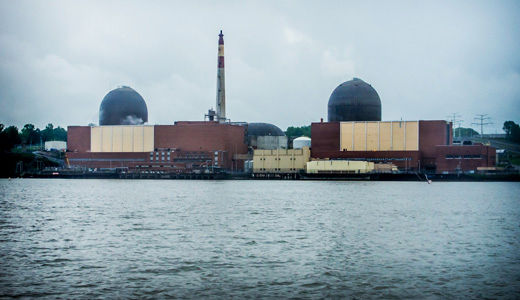
On February 5, the public learned that a leak at the Indian Point nuclear power plant, just 25 miles north of New York City, had released radioactive contaminants into the area groundwater, causing radioactivity levels 65,000 percent higher than normal. The groundwater flows into the Hudson River. The aging plant, owned by Entergy Corp., was commissioned in the 1970s and has had big toxic leaks previously. Federal and state investigations are in progress. This article relates the author’s experiences working in the plant.
NEW YORK – As an ironworker you can end up working in some interesting places. Indian Point nuclear plant, about an hour north of New York City along the Hudson River in Buchanan, N.Y., was one of them. Periodically the plant has planned outages to do maintenance and improvements in the plant. My union local sent me up to work during one of the outages. It was a particularly bad year on the heels of the big financial crisis of 2008, and I had been bouncing around from job to job. Now, most jobs, you show up, have a brief safety training, and get to work. Not at a nuclear power plant. Two weeks of orientation and safety training, a 500-question multiple choice mental stability test, drug tests and FBI background check are required. You get paid, most of the training is indoors and it was winter, so why not?
Of course a little bit of it was sitting through Entergy’s corporate propaganda about the benefits of nuclear energy – it supplies 25 percent of the downstate area’s power and, while recognizing the potential dangers, management said, it complies strictly with the Nuclear Regulatory Commission’s operating guidelines. The presentation wasn’t over the top as I expected, although I was informed about natural existence of radiation all around us. It’s in bananas after all, and who doesn’t like bananas? I do.
Two weeks later, training completed, and somewhat to my disappointment FBI background check cleared, I was OK’d to go to work.
Even though Indian Point is one of the original nuclear power plants built in the United States 40 years ago, you have this expectation that given the potential dangers of nuclear power, the plant would reflect the up-to-date clean energy image that nuclear energy proponents like to project. I was kind of shocked at how decrepit the facility seemed. Paint peeling on the walls, rusty pipes, water damage. The complexity of the plant was confounding too. Passageways here and there, and of course restricted areas. It did not inspire confidence in the state-of-the art image the nuclear industry likes to promote.
So I was not entirely surprised when two weeks ago the company reported alarming levels of radioactive tritium in the groundwater, with one monitoring well’s levels increasing 65,000 percent and more recent samples showing a continued increase of 80 percent from the original samples.
The New York Daily News reported, “The leak occurred after a drain overflowed during a maintenance exercise while workers were transferring water containing high levels of radioactive contamination.”
Oops!
Entergy officials say that there is no threat to public health or safety. The contamination numbers “remain less than one-tenth of 1 percent of federal reporting guidelines,” the company said in a statement, adding the higher levels are “fluctuations that can be expected as the material migrates.” Migrates where, though? Into the groundwater and nearby Hudson River and downstream?
In fact, journalist and technology expert Roger Witherspoon says, “there is no indication that the company has developed the ability to prevent the latest uncontrolled leaks from following the underground waterway into the Hudson. And because the river is a tidal estuary flowing as much as 20 miles above and below the nuclear site, radioactive contaminants may be sucked into the drinking water systems of several river towns.”
He points out that a New York State Coastal Zone Assessment issued last November “expressed concern about the periodic leaks into the Hudson River because it serves as a direct water source for Poughkeepsie, Wappingers Falls, Highland, Port Ewen, East Fishkill, Hyde Park, and the Village of Rhinebeck. It is also a backup water source for some 9 million residents of New York City and Westchester County.” The assessment notes that the Croton Reservoir, which supplies drinking water to New York City, is only 6 miles from Indian Point.
Environmental groups such as Riverkeeper have called for Indian Point’s immediate closure. New York Gov. Andrew Cuomo said, “The trends of unexpected outages and environmental incidents like these are extremely disconcerting,” and called on federal authorities to not renew the plant’s license, which would mean its eventual closure. However Senator Chuck Schumer, D-N.Y., who supports the plant’s closing, has rejected its immediate closure, citing its role in providing affordable electricity rates. Schumer said: “I have told some of the environmental people, if you can show me a plan to figure out a way to replace that electricity, fine, but if you can’t, it’s going to raise electricity rates 30 or 40 percent, which are high enough on average people and that’s not the way to go.”
But Riverkeeper tells another story. In its 2011 study on retirement options for the plant, the organization cites “ample existing and new resources available to replace Indian Point if it were to retire; and … neither New York City’s nor New York State’s electricity reliability would be jeopardized. A replacement scenario focusing on cost-effective demand-side resources, local renewable resources, repowering of existing older inefficient power plants and new efficient generation as necessary would maintain reliability at a low cost to electricity customers.”
Others have argued that the plant is an important economic engine for the area. Nearly 1,000 full-time workers and nearly 4,500 jobs statewide are generated from the plant’s operation, says the pro-industry Nuclear Energy Institute. But the jobs argument has never been that convincing to me. We never seem to do much to stop plant closings when the corporate bottom line is at stake, no matter what the impact is on the local economy. Why should it be different here, when public health and the environment are at stake?
Of course replacing Indian Point as an energy producer and economic engine no doubt would be a challenge, requiring investment in energy infrastructure across the state as well as renewable alternatives, which of course means jobs. But it’s a challenge most reasonable people would agree we could meet if there is the political will, which makes Senator Schumer’s comments all the more disappointing. We elect our leaders to face these challenges.
It’s been six or seven years since I worked at Indian Point. It is in a beautiful part of the Hudson Valley. When I was there, bald eagles had recently made their appearance in the area, nesting right alongside the Hudson River near the plant. It was the first time I had seen bald eagles in the wild. Even the plant’s presence doesn’t diminish the beauty of the area, and one could be forgiven for seeing it as an example of the clean energy promise of nuclear power.
Just stay away from the water.
Susan Webb contributed to this article.
Photo: Indian Point nuclear power plant, next to the Hudson River, photographed in 2012. Wikimedia Commons












Comments